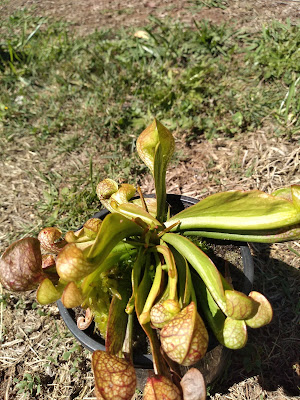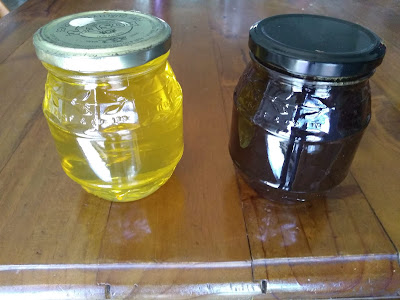I played around with aquaponics on a very small scale a few years ago. I had a small tank of ornamental fish in a classroom. The water stayed pristine, the fish thrived and the plants did remarkably well.
My kids have been bugging me for a few years to get fish again. We have no space in the house for a tank. I do have some barrels outside, so thought I could put fish in one of them.
Goldfish are hardy and long lived. They can survive in clean water as well as dirty water, they can survive in warm water as well as under ice. Goldfish can eat a wide range of foods, many of which I can grow for free and I will only need to buy some of their food. So I decided to get some goldfish.
One problem I faced is that goldfish are expensive here. Locally they are about $9 each for smaller, not very colourful fish, and more for better looking or larger fish.
Then I found a place online that posts live fish. They had a deal where I could get ten posted to me for much the price I would have spent buying three locally. I have never had fish posted before, but they had a live fish guarantee so I figured I would give it a go.
I could have bought ten comet goldfish, or the same price to get ten shubunkin goldfish, so I had to make a decision.
 |
| Goldfish when they arrived in the post |
I love shubunkin, they are prettier than most common goldfish and have an array of colours. Comets tend to be orange, or sometimes have a little white.
The choice was easy enough to make. I ordered some shubunkin goldfish.
Shubunkin tend to be less inbred than many other
varieties of goldfish, they have short single fins, and long bodies, meaning that they
suffer from fewer of the ailments that often kill fancy goldfish. They are colourful and meant to be one of the hardier breeds.
 |
| Who knew goldfish cope so well being posted interstate! |
When the fish first arrived they were terrified, and were rather pale in colour. All were alive and looked remarkably well.
They were active and it didn't take them long to colour up quite a lot. In the beginning they tried to stay down the bottom of the barrel where it was difficult to see them. They were scared, and I was worried that some would die in the first few days while the barrel was cycling. I put some wire over the top to protect my new fish from birds.
For the first few days I fed them duckweed and mosquito wrigglers. That way they could eat when they wanted and not have to worry about me looming overhead. After they associated me with food I started to also feed fish food. Now they come to the top of the barrel anytime they hear me. I now feed them some fish food. They are remarkably interactive fish, which makes feeding time quite fun.
I keep hearing how goldfish don't stop eating and will gorge themselves and eat to death, but mine only eat a little fish food and then stop. If I put a lot of duckweed on they will eat a lot, and then stop. Some times it takes a few days for them to eat all the duckweed.
 |
| Goldfish, duckweed, and floating plants |
I bought a little submersible pump/filter, floated a pot of plants to help remove some nitrates, and have plans for a flood/drain grow bed for when the weather warms up. Until I put in a grow bed I am also doing 10% water changes each week, this water goes to the vegetable garden or to fruit trees so nothing is wasted.
Most days I put a scoop of duckweed on the top of the water. The duckweed is great but only lasts a little while before my fish eat it. Luckily I have a lot of it growing in other containers so I can scoop more of it in each day. I also give them scoops of azolla but they struggle to eat that because their mouths are a bit too small.
Some of the larger azolla has stayed there for a long time, I am happy with this as it would be removing a tiny amount of the nutrients from the water.
I try to always have a little duckweed or azolla in there so they always have something to eat. They seem to prefer duckweed to fish food.
 |
| My barrel full of fish |
I am not a photographer and find it almost impossible to photograph fish. They are beautifully coloured, each is uniquely coloured, they are very active, rather interactive, and the kids find them interesting to watch.
I got them mid March and they have doubled in size over the past month or so. The plants in the floating pot have also exploded in growth, which is a good sign that they are removing some of the nutrients from the water. At first the fish were eating all the roots, but now the roots are growing faster than they are being eaten.
I know that ten fish are a lot for one barrel. But I have a few plans for the future which should help a lot. I am excited to see how much these little guys colour up after they have had some sunlight and more live food.
 |
| The fish are growing larger and calmer |
 |
| The plants are growing well |
 |
| Shubunkin feeding time |
Winter will be here before I know it, and my little fish won't be very active until the weather warms up again.
If my little fish survive the winter they should be large enough to breed in spring. I plan to put in a spawning mop and see what happens. If they lay eggs on the spawning mop I will remove it and put it in another tank and try to grow out some of the fry.
For now I am just enjoying these lovely creatures and watching them grow.
FOUR MONTH UPDATE: I now pump the water through a milk bottle full of gravel. This has increased biological filtration and provides greater aeration. I still have ten goldfish, they all have grown a lot and their colours are beautiful. Being winter they are moving very slow. The plants in the floating pot of gravel have increased in size dramatically and even in mid-winter I have started to harvest the Vietnamese Coriander!

















































